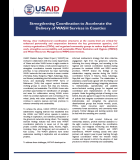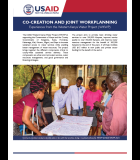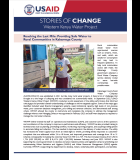Kenya Arid Lands Disaster Risk Reduction (KALDRR-WASH)
The Kenya Arid Lands Disaster Risk Reduction Water Sanitation and Hygiene activity worked to increase access to clean water and improve sanitation and hygiene in Kenya’s arid lands to more than 160, 000 vulnerable people. The activity was part of a larger effort to assist the Kenyan government and local communities to increase their resilience to droughts and flooding caused by a changing climate. Kenya Arid Lands Disaster Risk Reduction integrated and sequenced emergency relief efforts with long-term development efforts to increase water storage capacity and improve water, sanitation and hygiene conditions at health facilities and nutrition centers. It also improved access to and use of safe drinking water, point of use water treatment, and good hygiene behaviors to reduce diarrheal diseases.
Activity Description
The Kenya Arid Lands Disaster Risk Reduction activity implemented more than 250 infrastructure projects to improve sanitation and hygiene in homes, health facilities and nutrition centers. Access to clean water, improved sanitation, and good hygiene practices made people less vulnerable to malnutrition, even when an environmental or other shock causes food to be scarce. The key components of this strategy were:
- Improve WASH in homes, health facilities and nutrition centers
- Pilot advanced water use planning and hydrogeological approaches for improving water supply resilience
- Maintain emergency relief efforts with long-term development efforts
- Strengthen ties with development programs in other sectors
Expected Outcomes
- Increase water storage capacity in arid lands
- Improve WASH conditions at health facilities and nutrition centers frequently used during emergencies
- Improve access and use of safe drinking water, point of use water treatment, good hygiene behaviors and sanitation facilities as a means of reducing diarrheal diseases in areas with recurrent emergency levels of malnutrition and around areas of improved storage
Actual Outcomes
- More than 85,000 people with access to improved drinking water supply
- More than 53,000 people with access to improved sanitation facilities
- 55 new water points constructed in three months
- 45,930 cubic meters of water storage capacity created





